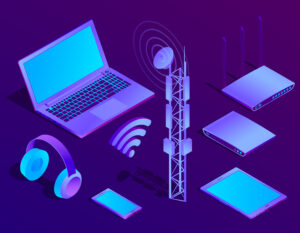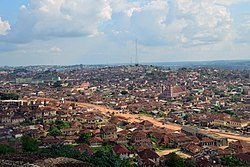
Nigeria is experiencing a surge in internet usage, driven by a growing population, rising smartphone adoption, and an increasing reliance on online services. However, a significant portion of the population, particularly in rural areas, still lacks access to reliable and affordable internet connectivity. This digital divide hinders economic growth, educational opportunities, and social inclusion. Fixed Wireless Access (FWA) emerges as a promising solution to bridge this gap and unlock the transformative potential of the internet for all Nigerians.
What is Next Generation Fixed Wireless Access (NG-FWA)?
Next Generation Fixed Wireless Access (NG-FWA) is a broadband technology that delivers high-speed internet access wirelessly. Unlike traditional mobile broadband, NG-FWA utilizes advanced technologies like millimeter wave (mmWave) and fixed wireless access technologies like 4G and 5G to provide a fixed and reliable internet connection similar to fiber optics.
NG-FWA utilizes base stations equipped with high-gain antennas that transmit data signals to customer premises equipment (CPE) installed on rooftops or external walls. This eliminates the need for physical cables, making deployment faster and more cost-effective compared to traditional fiber-optic networks.
Advantages of Fixed Wireless Access (FWA) for Nigeria
FWA offers several advantages that make it particularly suitable for addressing Nigeria’s connectivity challenges:
- Faster Deployment: Deploying fiber optic cables, especially in remote areas, can be a time-consuming and expensive process. FWA requires minimal physical infrastructure, allowing for quicker network rollout and faster time-to-market for internet service providers (ISPs). This is crucial for connecting underserved communities that might wait years for traditional wired infrastructure.
- Cost-Effectiveness: Laying fiber optic cables involves significant upfront costs for trenching and cable installation. FWA offers a more cost-efficient alternative, especially in low-density areas where subscriber numbers are lower. This translates to potentially lower internet subscription costs for end-users.
- Wider Coverage: FWA can cover larger geographical areas compared to traditional fixed-line technologies. This is particularly beneficial for reaching remote communities, peri-urban areas, and geographically challenging terrains where fiber deployment might be impractical.
A 2023 NCC report highlights that just under 40% of Nigerians have access to the internet. FWA has the potential to significantly increase this number by reaching those currently excluded from the digital revolution.
Case Study: Bridging the Rural-Urban Divide in Ogun State

Imagine a community like Ayetoro, a rural village in Ogun State, Nigeria. For years, residents struggled with limited internet connectivity, hindering educational opportunities and access to online services. However, a recent FWA project by a local ISP transformed the landscape. By installing base stations and CPEs in strategic locations, the ISP delivered reliable and affordable internet access to the community. Students can now access online learning resources, farmers can connect with digital marketplaces, and residents can enjoy the benefits of e-commerce and online communication. This case study exemplifies the transformative power of FWA in bridging the rural-urban digital divide.
Limitations of Fixed Wireless Access (FWA)
While FWA presents a compelling solution, it’s essential to acknowledge its limitations:
- Line-of-Sight Dependency: FWA relies on a clear line of sight between the base station and the CPE. Obstructions like buildings and trees can disrupt the signal and impact performance. This might be a challenge in densely populated urban areas.
- Weather Sensitivity: Heavy rain or extreme weather conditions can temporarily weaken the FWA signal, potentially causing connectivity issues.
- Limited Bandwidth Sharing: The available bandwidth is shared among users within the coverage area of a base station. This could lead to congestion and slower speeds during peak usage times, especially in high-density areas.
The Future of FWA in Nigeria
Despite these limitations, advancements in technology are addressing them. Millimeter wave (mmWave) technology offers higher capacity and wider coverage, while advancements in antenna design are improving signal resilience. Additionally, proper network planning and infrastructure development can mitigate bandwidth-sharing concerns.
The Nigerian government, in collaboration with the NCC and private telecom companies, plays a crucial role in shaping the future of FWA. By creating a regulatory environment that encourages investment, facilitating spectrum allocation for FWA technologies, and promoting infrastructure development, stakeholders can unlock the full potential of FWA in bridging the digital divide.
The Role of Stakeholders in Advancing FWA
Several stakeholders play a critical role in shaping the future of FWA in Nigeria:
-
Nigerian Government:
The government can create an enabling environment for FWA development through:
- Policy and Regulatory Framework: Streamlining regulations and simplifying licensing procedures can incentivize private investment in FWA infrastructure.
- Spectrum Allocation: Allocating adequate spectrum for FWA technologies like 4G, 5G, and mmWave is crucial for network capacity and improved performance.
- Infrastructure Development: Government initiatives focused on building critical infrastructure like power grids and fiber backhaul networks can support the rollout of FWA services.
-
Nigerian Communications Commission (NCC):
The NCC plays a vital role by:
- Promoting Fair Competition: The NCC can ensure a level playing field for all FWA players, fostering healthy competition and promoting innovation in service offerings.
- Consumer Protection: The NCC should establish clear guidelines regarding service quality, data caps, and pricing transparency to protect consumer interests.
- Capacity Building: The NCC can support capacity building initiatives for the FWA workforce, ensuring a skilled pool of professionals for network deployment and maintenance.
-
Telecom Operators and ISPs:
Telecom operators and ISPs will be at the forefront of FWA deployment. They can contribute by:
- Strategic Network Planning: Operators should conduct thorough network planning to ensure optimal base station placement, mitigating line-of-sight challenges and maximizing coverage.
- Investment in Technology: Investing in next-generation FWA technologies like mmWave and exploring innovative solutions like mesh networks can further enhance network capacity and resilience.
- Affordable Service Packages: Developing targeted service packages catering to different user needs and income levels can make FWA more accessible to a wider population.
The Road Ahead: A Connected Nigeria
The future of FWA in Nigeria is bright. By leveraging its unique advantages, addressing existing limitations, and fostering collaboration among stakeholders, FWA can bridge the digital divide and connect millions of Nigerians. This will unlock a wave of socio-economic benefits, including:
- Enhanced Education: Reliable internet access will empower students with access to online learning resources, educational apps, and virtual classrooms, ultimately improving educational outcomes.
- Economic Growth: FWA can facilitate the growth of e-commerce, online businesses, and digital entrepreneurship, contributing to job creation and economic development across the nation.
- Improved Healthcare: Broadband connectivity can revolutionize healthcare delivery by enabling telemedicine services, remote patient monitoring, and access to online medical resources.
- Social Inclusion: Connecting rural communities will provide access to online communication tools, social media platforms, and government services, fostering social inclusion and empowering citizens.
Conclusion
Fixed Wireless Access (FWA) offers a promising solution to bridge the digital divide in Nigeria. Its advantages of faster deployment, cost-effectiveness, and wider coverage make it particularly suitable for reaching underserved communities. While limitations like line-of-sight dependency and weather sensitivity exist, advancements in technology and strategic infrastructure development are working to address them. With continued government support and industry collaboration, FWA has the potential to play a transformative role in ensuring
